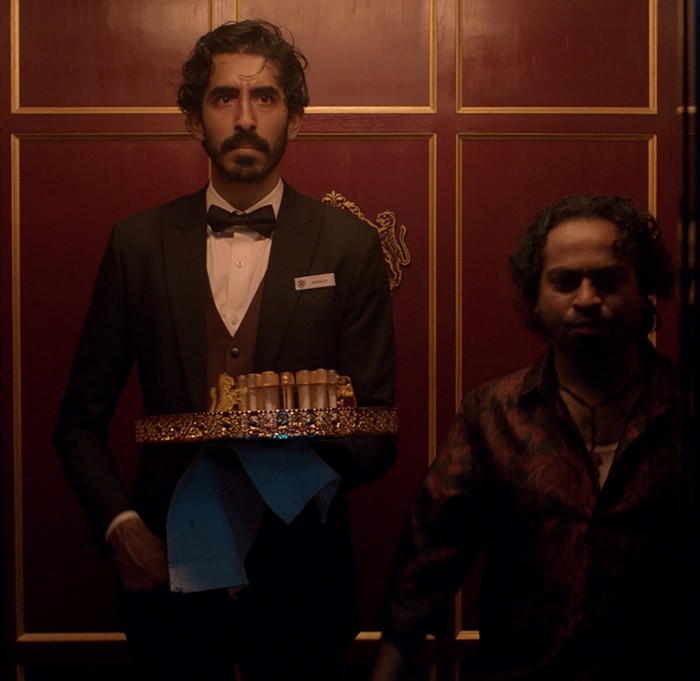We go to the movies to watch people get hurt. There is no shame in this; human beings have a built-in urge to witness pain. Whether it’s emotional or physical, we line up at the theater to see our collective trauma made big and loud.
From Buster Keaton breaking his neck on Sherlock, Jr., to Johnny Knoxville breaking his neck on Jackass Forever, cinema is, down to its bones, an art of violence. Dev Patel seems to know this intuitively. Monkey Man, the British actor’s directorial debut, is a paean to the transformative, spiritual power of cinematic violence. Sopping wet and bathed in crepuscular neon, the film goes hyper-gnarly on human flesh.
Patel plays an unnamed street-urchin-turned-street-fighter who, disguised in a ragged gorilla mask, sublimates his rage in nightly, rigged fights set up by greasy promoter Tiger (Sharlto Copley). Glimpses of the origins of that rage, as well as why Patel’s character’s hands are so badly scarred, emerge as he plans the ultimate vengeance: A take down of the police chief (Sikander Kher) who killed his mother, as well as the political-slash-cult leader (Makrand Deshpande) who enabled the chief and destroyed our protagonist’s village. By “take down,” Patel clearly means “brutally murder.”
With cinematographers Simon Temple and Sharone Meir—the latter most recently, and most appropriately, lensing John Woo’s also-flagrantly-violent Silent Night—Patel pushes his protagonist through a pastiche of incredible action cinema. There are obvious echoes of John Wick, especially to the tune of “hirsute man in beautifully-fitting suit massacres whole room of thugs” (though Tenet-heads may remember John David Washington’s kitchen brawl as a nice corollary to Monkey Man's gory kitchen melee), but Patel also points to grim Korean thrillers like The Man from Nowhere and The Villainess, or to the squelching, viscera-spattering mayhem of Indonesian action filmmakers like Gareth Evans and Timo Tjahjanto, or even to the Hindi blockbusters of Shah Rukh Khan, whose Koyla from 1997 Patel cites as a particular influence on his character’s dripping, beady-eyed mania. One could even claim that Monkey Man’s training montage, in which our hero develops an unspoken bond with renowned tabla drummer Zakir Hussein to push his body to the limit, is modeled after the training montage in Rocky III, when Rocky must learn what it takes to find another fighter’s rhythm.
All of this foundational violence Patel infuses into Monkey Man’s action scenes, a barrage of hand-to-hand (and knife-through-hand) combat, intensely edited and kept close to the pores, but still given a solid sense of space. They’re demonstrations of both Patel’s physical prowess and the ravenous grasp he has on a production teeming with so much energy. This is satisfying action: By tracking Patel’s unleashed simian warrior, a lithe and restless silhouette, through higher and higher echelons of disposable opponents, we are promised the ultimate payoff when he reaches the top.

This is how it goes for revenge flicks, and Monkey Man is, among many styles and subgenres that could apply, a revenge flick. It’s a power fantasy too, at least to the extent that in it an oppressed outsider is empowered to incinerate the oppressor down to its rotten roots.
Inspired by the story of Hanuman, the monkey god described in memories of his mother, Patel’s titular gorilla-masked vigilante becomes a hero for India’s marginalized, even seeking refuge in a temple maintained by a small group of hijras (India’s “third gender”) for the aforementioned training montage.
An introduction of con men and sex worker archetypes, along with various downtrodden-coded extras, provides the so-called monkey man a solid cause for which to sacrifice his body. Patel beats the point over the head by making overt comparisons to the reality of India’s still-prevalent caste system, interspersing footage of police brutality and government-sanctioned beatings with the film’s extreme bloodletting. But shallowly drawn characters and grisly by-the-books backstory hardly matter once the carnage begins, which is relentless and obliterative.
Maybe that’s too blunt a reading of the film’s worldview, that the only response to oppressive authority is total annihilation. Patel likely does not think a vigilante—however emboldened by social justice—should lead a one-man war against a major metropolitan police chief. But violence absolutely courses through Monkey Man. It defines it.
Where even John Wick could be interpreted as a treatise on how murdering every person on earth is bad (violence begets only more violence, etc.), Monkey Man wields vengeance as a way to cleanse one’s soul. There is no lesson here, only exorcism. There is no moral question here, only the face of a guy who definitely deserves it, pounded to a bloody pulp. My god, it’s invigorating.
Monkey Man begins playing at theaters in wide release Fri April 5.




















